Post by 0ez on Feb 1, 2011 0:54:59 GMT -5
Özkraine Society
Table of Contents
- The People
- The Calender
- The Cities
- The Sietch
- The Direship
- The Religion
- Women
- The Ön Language
The People
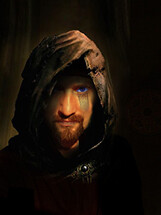
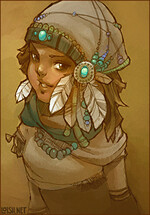
A male and female Özkrainian
The Özkrainian people are a melting pot of ethnicity, and nobody knows the exact ethnic makeup of its people. From findings of the ÖAA (Özkrainian Archaeological Association), they found that the majority of the first scientists were of Western European descent (especially English, French, and German), and of the later immigrants they found that they came from all ethnicities of earth. The ÖAA then estimated from all their information about the earth ethnic makeup of its colonists consisted of 40% Western European, 25% Middle Eastern, 20% East Asian, 5% Latin American, 5% African, and 5% Eastern European. However, no Özkrainian is possibly pure of one ethnicity as the colonists meshed almost perfectly. A theory about this phenomena is about the air Özkrainians breathe, which is thought to enhance the vividness of dreams as well long-term indiscrimination and brotherhood between all humanity.
The typical Özkrainian look is hard to pinpoint. Their skin tone can be represented by a skewed right bell curve, and the range of the tones ranging from a light tan to a light black complexion. Most Özkrainians typically have a deep tan. Whatever chemical is in the air they breathe and the Zuavka that Özkrainians smoke and eat causes their eyes to cast an odd florescent glow when they turn 6 years old. Because of the genetic melting pot, their eye color is usually different between other Özkrainians. The most common colors are blue, brown, and green, but a growing proportion of the population are developing heterochromia and more odd eye colors like purples, yellows, grays, light blues, pinks, and multicolored. Hair color is much more standard among the Özkrainian population, only ranging from a light brown to a dark brown. However, that isn't to say some have blonde, red, or black hair. The Özkrainian people are unusually tall with an average height of 5'11'' among both genders.
The typical Özkrainian look is hard to pinpoint. Their skin tone can be represented by a skewed right bell curve, and the range of the tones ranging from a light tan to a light black complexion. Most Özkrainians typically have a deep tan. Whatever chemical is in the air they breathe and the Zuavka that Özkrainians smoke and eat causes their eyes to cast an odd florescent glow when they turn 6 years old. Because of the genetic melting pot, their eye color is usually different between other Özkrainians. The most common colors are blue, brown, and green, but a growing proportion of the population are developing heterochromia and more odd eye colors like purples, yellows, grays, light blues, pinks, and multicolored. Hair color is much more standard among the Özkrainian population, only ranging from a light brown to a dark brown. However, that isn't to say some have blonde, red, or black hair. The Özkrainian people are unusually tall with an average height of 5'11'' among both genders.

A typical set of glowing Özkrainian eyes
The Calender
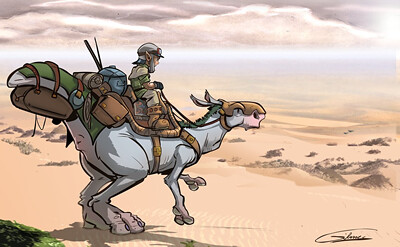
An Özkrainian nomad on his packed Sakatir
At the start of SSTGalaxies, the Özkranian calendar’s date is 29.2.3.3, which reads the 3rd day of Dwayar in the 2nd Feeryar of the 29th year after the Common Awakening. An O year is 984 O days (1230 earth days) and an O day consists of 30 earth hours.
Timescale:
The Common Era
4 Feeryar in a Year
246 Days in a Feeryar
30 Hours in a Day
Months:
Einuar (25 Days)
Zwoyar (23 Days)
Dwayar (26 days)
Feerial (24 Days)
Quintila (25 days)
Sechstembar (24 Days)
Septembar (25 Days)
Achtobar (25 Days)
Navimbar (24 Days)
Deksimbar (25 Days)
Holidays :
Einuar 1st Nuyarday (New Year’s Day)
Zwoyar 10th Zuavkaday (“Happy Day”)
Feerial 7th Luverkali (“Celebration of Oerdalov (Erotic Love)”)
Quintila 5th Quintiliaquintquam (Celebration of the 2nd Unification {national day})
Navimber 11th -15th Arbeitdays (Celebration of Work)
Navimber 16th – 22nd Freidays (Labor Days)
Deksimbar 1st Sanktoezday (Celebration of Saint Öz)
Deksimbar 25th Finday (New Year’s Eve)
The Cities

The City of Saint Taramak, location in the southern hemisphere around the 38th parallel. An excellent example of the post-republican settlement
5 Largest Cities
Oa- ~800,000
Atlea- ~450,000
Saint Taramak- ~400,000[
Saint Dautin- ~250,000
Floritika- ~200,000
Oa- ~800,000
Atlea- ~450,000
Saint Taramak- ~400,000[
Saint Dautin- ~250,000
Floritika- ~200,000
When the planet O was under the oligarchy and a new colony, the entire population lived in what is now Oa. During the Özkrainian Darkness, 80% of the colonists abandoned Oa and other early colony settlements to set out and find an area called their home. By the reawkening, Almost 100% of the Özkrainians lived out in the wilderness, part of small communes called Sietches.
Ever since however, this percentage changed to 10% in urban areas. The cause of this was thanks to the early hydroponic research of the Parpaski direship. The rate of Urbanization is slowing down, as most Özkrainians enjoy the feel of wilderness and vast openness, rather than the feel of cities.
There are three types of cities in Özkraine, colonization, post-republican, and neo-republican. Each have their own architectural types. Typically a post-republican city takes the name of the founding Listener and has the honored title of 'Saint' in front of it. The only pure neo-republican city is Floritika, which is an emerging city responsible for most research and manufacturing on the planet. Old colonist cities are very important to Özkraine as they contained vast information and old infrastructure for manufacturing. The most important job used to be those named "Archaeologists". However instead of preserving material for a museum as one would think, Özkrainian Archaeologists were responsible for interpreting old documents, further developing the Ön language, and restoring old factories.
Cities control most of the political choices of the planet as their citizens are most likely to vote and be represented by the Özkrainian people, and although the cities have emerged, the social structure of the small sietches are still prevalent inside the cities. Among the most powerful groups on the planet are known as Direships, large monopolistic/paramilitary factions that vie for power of the senate and interplanetary commerce. Primary shareholders and higher members of direships represent only 0.25% of the Özkrainian population, however they dominate 60% of the Özkrainian GDP.

The Planet's Capital City of Oa, an excellent example of Colonization settlement. However with the aging first buildings, Neo-Republican architecture is taking hold, especially around the new palace and government buildings.
The Sietch
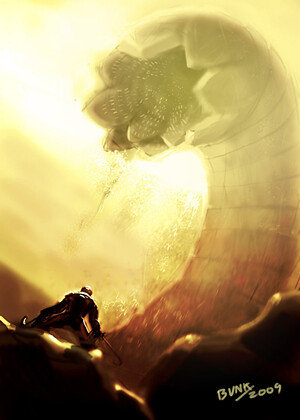
A Nomad performing the ritual of Ferbevelti, the calling of the worm.
Making up 90% of the population, the sietch represents the social structure that holds up Özkrainian society. A sietch can be as small as 10 people and as large as 10,000. To be a sietch, as documented in the book of Saint Oz, he said there must be a spiritual leader named a Ourer ("one who listens to Gaea's whispers") and a Virtshaefor (One who leads the sietch in resource management and also a military leader.) Several larger sietches will divide up the work of a Virtshaefor or even an Ourer to maintain stability. Both the Ourer and Virshaefor must name a succession of at least 5 people among his most able members and then train a new generation of leaders and religious priests and priestesses.
Not all members of a sietch will be in one exact place, but they do share meeting areas in caves and old remote temples. Technically, cities are considered sietches as they meet the requirements for a legal sietch, but aren't considered so because of their large size and lack of collective adherence to the cultural traditions of Özkraine. Among those traditions are those listed as Holidays. The most significant holidays for the sietch are Sanktoezday, Luverkali, Nuyarday and Finday, and Zuavkaday. All of these holidays hold a special religious emphasis among the Özkrainians, and the other holidays are more predominantly practiced in the cities. However days such as the labor days and Quintiliaquintquam, have been finding more acceptance in the sietch society. On the religious holidays is when a whole sietch (or a group of smaller sietches) come together as a whole unit to trade, celebrate, procreate, and communicate. Typically the meeting area is only occupied by teachers, mothers, nurses, priests/priestesses, the Ourer, and children during the off holidays. Those who leave come back with various nomadic goods and give back their surpluses to their partners and the sietch as a whole.
A new statistic among Özkrainian Women is that pregnancy takes month longer than it was Earth. In O-time, that is a little under one veertal (1/4th of an O Year), and therefore the most common birthdays of Sietch-dwelling Özkrainians lay a week or two before one of the four holidays (the single most common birthday lies before Luverkali). After a child is born, the mother stays with the child to nurse and care for the child for (at max) the first five veertals of its life. Sometimes a mother will only spend one or two veertals with the child, then transfer the responsibility to a sietch nurse. Once the child becomes 5 Veertals old, they must begin their education. The responsibility of a parent or a nurse is to teach every child how to speak and at least identify every letter of the traditional Ön alphabet before they begin their education. The first few veertals of a child's education involve basic trekking and discovery in the desert, geography of O, basic arithmetic, and reading. A child must prove themselves as literate by their 8th veertal, those who don't (about Under 1% of children) must suffer the penalty of death. During the 9th veertal, children typically begin learning proper martial arts, how to fire a weapon, the basics of animal husbandry, and other survival techniques. The child is required to have read the entire holy texts of Saint Oz by his 12th veertal, and must recite a certain section of the holy texts by the Sanktoezday of their 16th veertal in a ceremony known as the Valkoel(the section chosen by the Ourer makes sure that every person in a single generation is part of a puzzle piece that can recite the entirety of holy texts by speech, if for any reason the writings should become lost). After successfully completing the Valkoel, the child becomes a full member of the sietch and participate fully in every form of sietch life. Typically after the Valkoel they spend another 4 veertals learning a certain trade, (however more complicated roles can take more than 4, and some members of the sietch go to a city to study at a university and come back for the benefit of the sietch. Those who do not come back suffer death by contract). By the 20th veertal, all Özkrainians must attempt their first Ferbevelti (the calling of the worm), unless their role or condition hinder them to do so. Only about 25% of Özkrainians successfully complete the ritual by their 20th veertal, and every first attempt comes with the danger of death (About 5% of all first Ferbeveltis result in death, but this is a better figure than 15% about 20 O years ago). The earliest known Ferbevelti success was achieved by an 11 Veertal old.
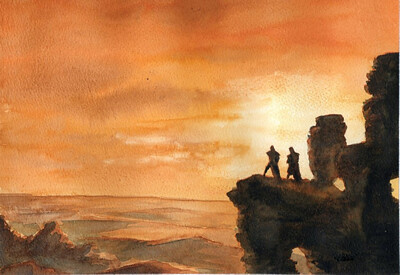
Two Özkrainian nomads exploring O's vast desert wasteland
The Direship
The direship is a relatively new secular system that is starting to shape Özkraine's current political affairs. Combined, private paramilitary services controlled directly by direships outnumber the current planetary military of Özkraine. Because of this, the government will sometimes hire the use of these paramilitary services to carry out military operations. However, during moments of crisis, the Sancta has the right to invoke Jihad, such a maneuver would force the Dires of their respective groups to surrender the powever of their group over to her in the defense of O. Refusal to do so would most likely cause the internal collapse of a direship, losing a dire all his assets.
The Religion
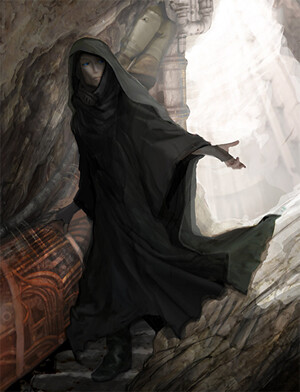
An Özkrainian High-Priestess known as "The Listener". The Listener of a Sietch is in charge of education, ritual, law, worship, and historical records.
Women

An Özkrainian Woman performing Ferbevelti
The Ön Language
